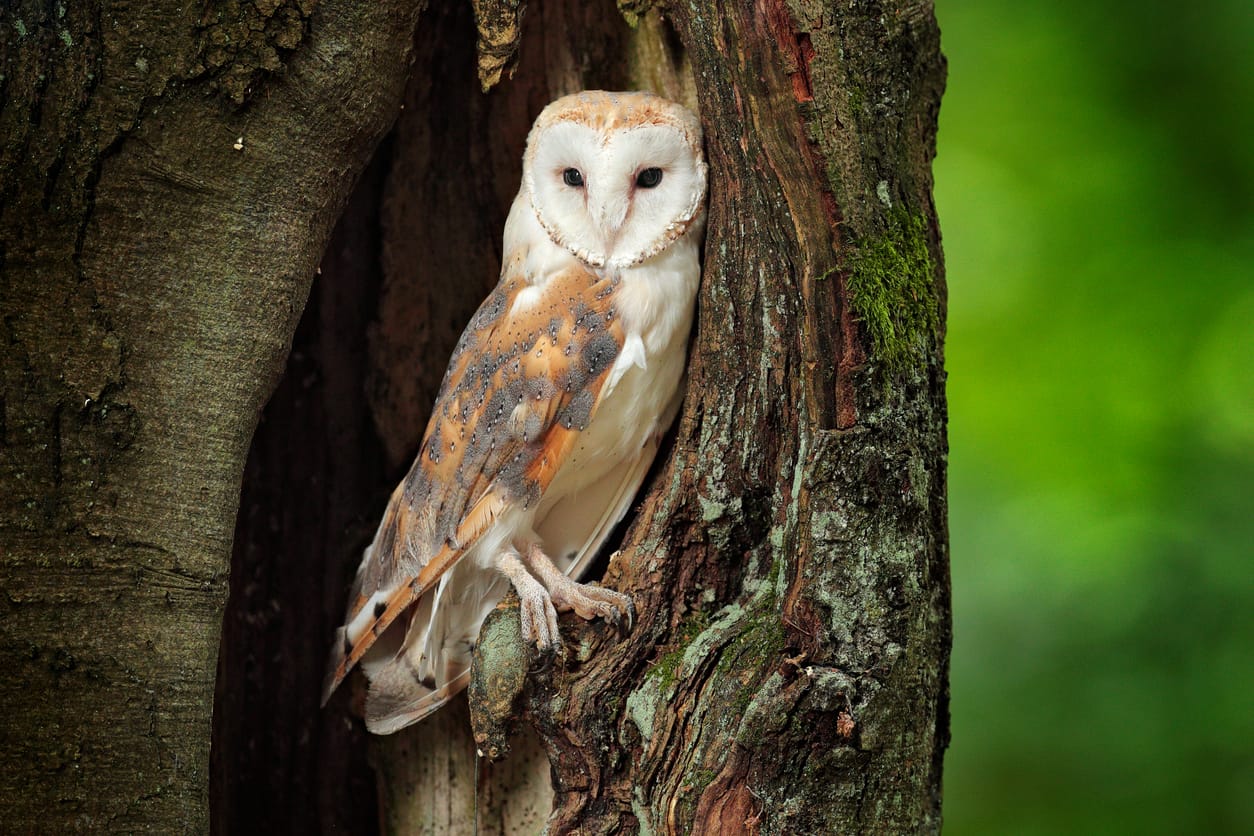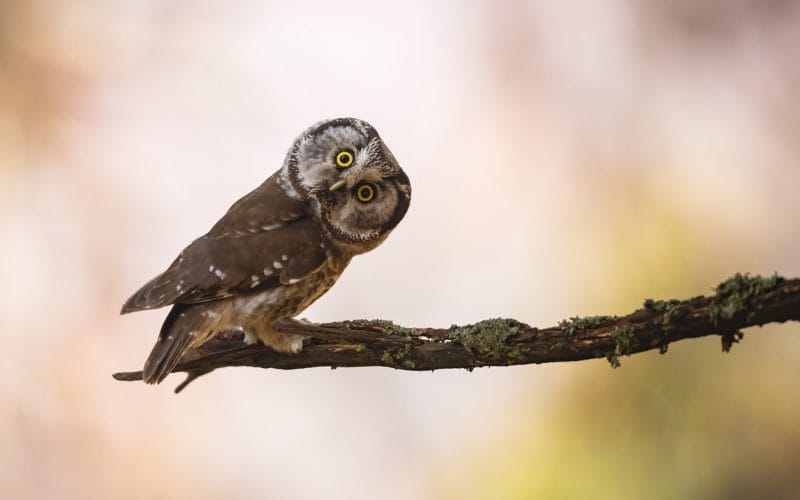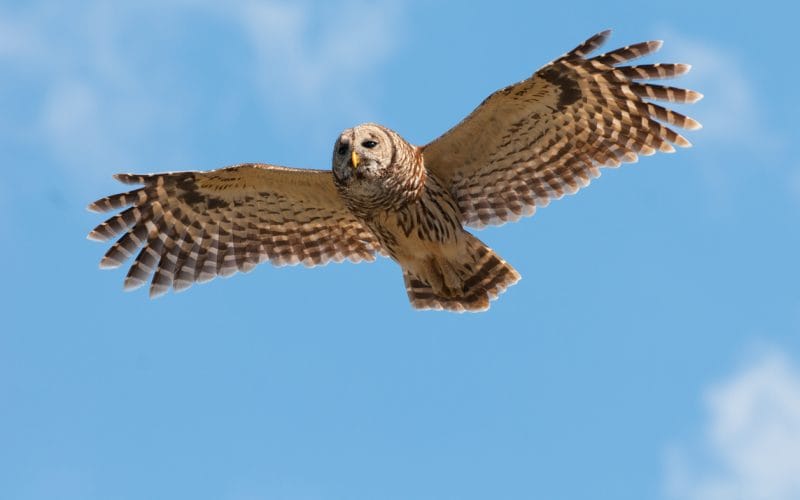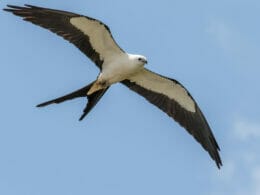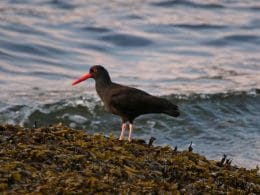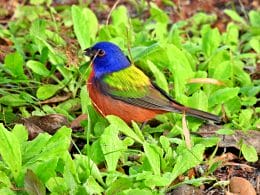North Carolina is one of the largest forested states in all of America, so it’s no wonder that the wildlife variety in the state is exemplary, and that applies to birds too!
In fact, according to official reports by the North Carolina Bird Records Committee, the Tar Heel State is home to over 490 species of birds, with many of them being owls.
If you want to find out more about these owls, their description, where they live, and what they eat, you’ve come to the right place!
In today’s article, we’ll provide you with a brief guide of all the owls in North Carolina, so without further ado, let’s dive in and see what these amazing birds of prey have to offer!
1. Great Horned Owl

- Scientific Name: Bubo virginianus
- Length: 18.1 to 24.8 in
- Weight: 32.1 to 88.2 oz
- Wingspan: 39.8 to 57.1 in
Kicking off the list with one of the most iconic species of owls that you can find in all of North America and not just North Carolina. In fact, the Great Horned Owl is the most common species of owls in the state, along with barn owls.
Top Tip: The great horned owl is also a non-migratory bird, so you’ll be able to encounter this majestic bird any time of the year.
This bird is also called the “tiger owl”, due to its similarities in looks and color patterns with common tigers. For instance, the adult owl has an orange to reddish-brown face, surrounded by a small patch of white coloration around the neck as well as a circular black ring.
Additionally, the bird has two relatively large ear tufts, which look like horns from a distance, which is where the raptor has got its name.
The rest of the owl’s body is usually mottled and varies from brown to gray, but the variety that is more common in North Carolina is pale gray, which helps it blend easily to its surroundings while perching on tree limbs.
The bird is mainly nocturnal and mainly hunts in open areas where it can catch small rodents, such as mice and squirrels. Despite that, this owl has adapted over the years to live around humans, so it can sometimes be found in residential areas, parks, and nearby forests.
2. Barn Owl

- Scientific Name: Tyto alba
- Length: 12.6 to 15.8 in
- Weight: 14.1 to 24.7 oz
- Wingspan: 39.4 to 49.2 in
Next up we have another owl that is also quite common in the State of North Carolina. The Barn Owl isn’t only common, but it’s also easy to identify because it looks a little different when compared to any other type of owl in the area.
These owls are average in size and have rounded long wings that help them fly in complete silence, especially when combined with their rounded smooth heads that lack ear tufts.
As the name suggests, barn owls like to live in open areas, especially when they’re abandoned or rarely disturbed at night, such as barns, churches, which explains why some people also call them “ghost owls”.
The most characteristic feature of this bird is its face. Barn Owls have a heart-shaped facial disc with a long nose, small peak, and very dark eyes, which is why some people may also call them “monkey-faced owls”.
The rest of the owl’s body is usually light brown to white in color, although they can also be found in other pale color combinations, including light gray and buff.
The strictly nocturnal bird can be seen hunting in open areas, marshlands, grasslands, or even in agricultural fields, where it can feed on rodents like mice, voles, shrews, and even small rabbits.
3. Barred Owl
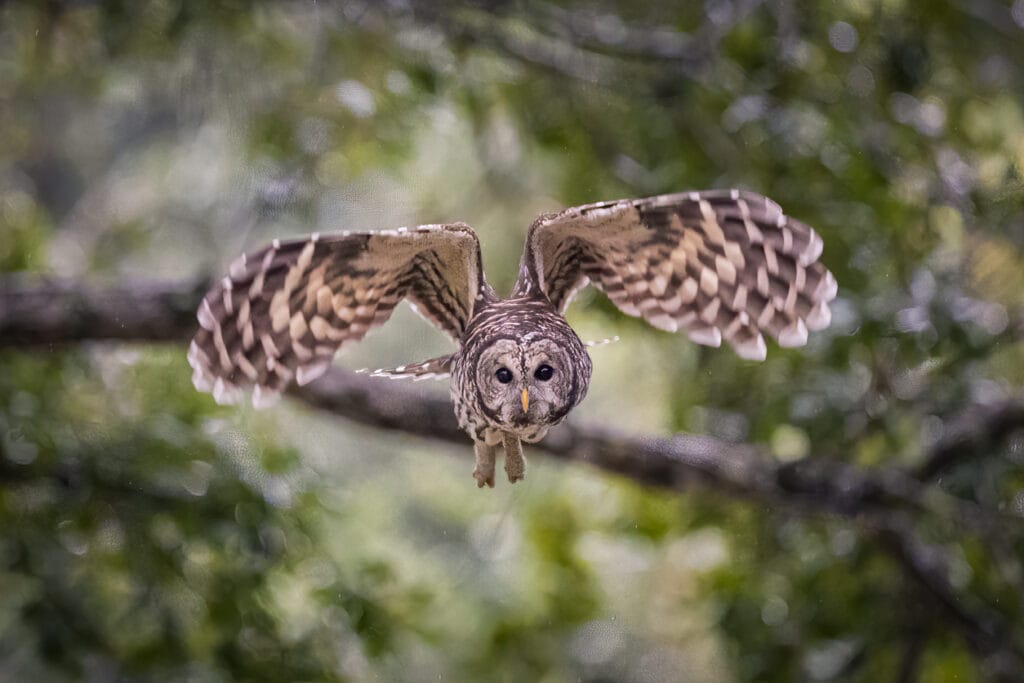
- Scientific Name: Strix varias
- Length: 16.9 to 19.7 in
- Weight: 16.6 to 37.0 oz
- Wingspan: 39.0 to 43.3 in
The Barred Owl is also pretty common in North Carolina, though not as common as the barn owl and the great horned owl.
The bird is considered a natural combination of the features of these two owls. For example, this bird is heavily mottled like the great horned owl. However, it has heart-shaped facial discs with small peaks, dark eyes, and no ear tufts like the barn owl.
This owl is native to the Eastern region of North America, including North Carolina, so you can find them all year round.
The heavy mottling of the birds looks like horizontal stripes from a distance, which is why they’re called barred or striped owls. These owls also have stripes on their underparts, but the bars are vertical rather than horizontal.
The bird exists in different varieties but the brown ones are the most common in North Carolina. They’re usually quiet during the day and become active during the night. They live in deep coniferous forests and have a very characteristic hooting sound.
4. Snowy Owl

- Scientific Name: Bubo scandiacus
- Length: 20.5 to 27.9 in
- Weight: 56.4 to 104.1 oz
- Wingspan: 49.6 to 57.1 in
Snowy Owls particularly live in Northern regions of the world, but they’re commonly found across the Carolinas where temperatures are favorable for juvenile species.
Unlike the previously mentioned species, they’re a noticeable difference between the males and females of this species of owls. For instance, adult males are usually completely white or have very little spots of brown across their wings.
These spots tend to go fainter as the owl grows older. On the other hand, females are also white but usually have noticeable barring all across their wings and backs.
Author Note: Both males and females have deep yellow eyes with striking contrast that makes them noticeable from a distance, so it’s pretty difficult to misidentify the owl.
Snowy Owls usually prefer staying in open areas with snowy ground. In fact, you’ll have the most luck spotting one when looking low to the ground.
They also like to fly and sit near the ground (sometimes next to lakes) looking for their food, which includes rodents like lemmings, hares as well as ducks, and small seabirds.
5. Burrowing Owl
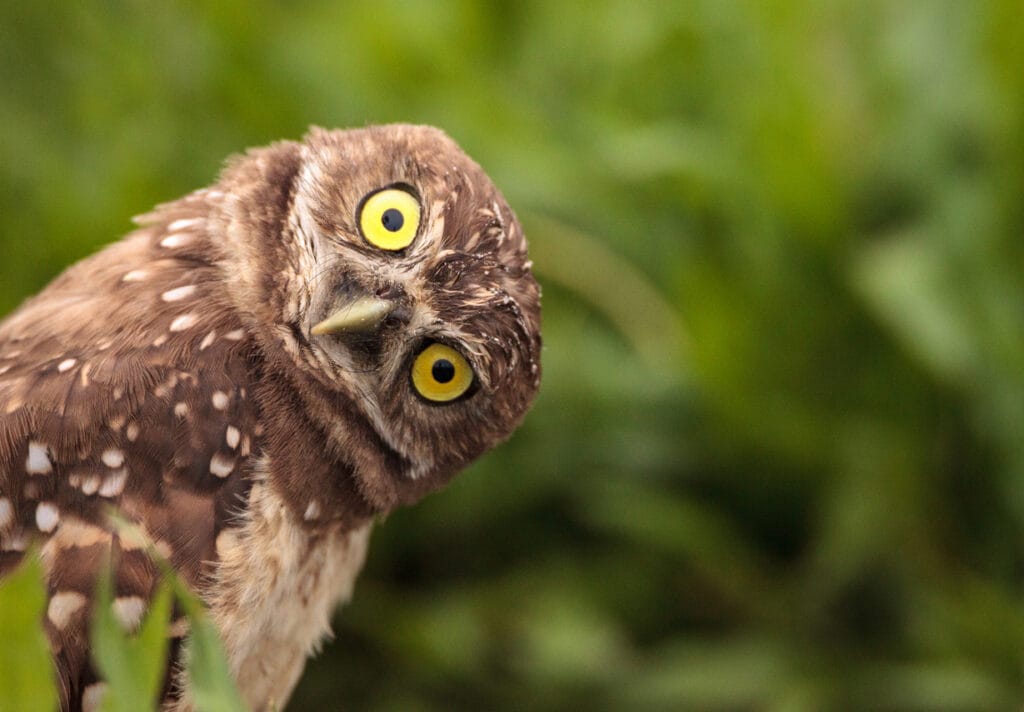
- Scientific Name: Athene cunicularia
- Length: 7.5 to 9.8 in
- Weight: 4.9 to 5.3 oz
- Wingspan: 20.8 to 21.6 in
While the general consensus about owls is that they’re mostly or strictly nocturnal, the Burrowing Owl isn’t, as it’s most active during the day.
These owls are relatively small compared to previously mentioned owls, as they’re smaller than the average American crow. The bird has long thin legs that are not covered with feathers as well as a very short tail.
Burrowing Owls also have smooth heads with no ear tufts. They have a common brown to pale brown mottling across their bodies as well as deep yellow eyes.
Like the Snowy Owl, these raptors also like to spend most of their time close to the ground and typically fly low.
This makes prairies and other areas with scattered shrubs and low vegetation a good spot to blend and catch their prey.
The birds usually feed on large insects, such as beetles, grasshoppers, and crickets, especially during the summer, but they can also prey on squirrels and voles when their paths cross.
6. Northern Saw-whet Owl
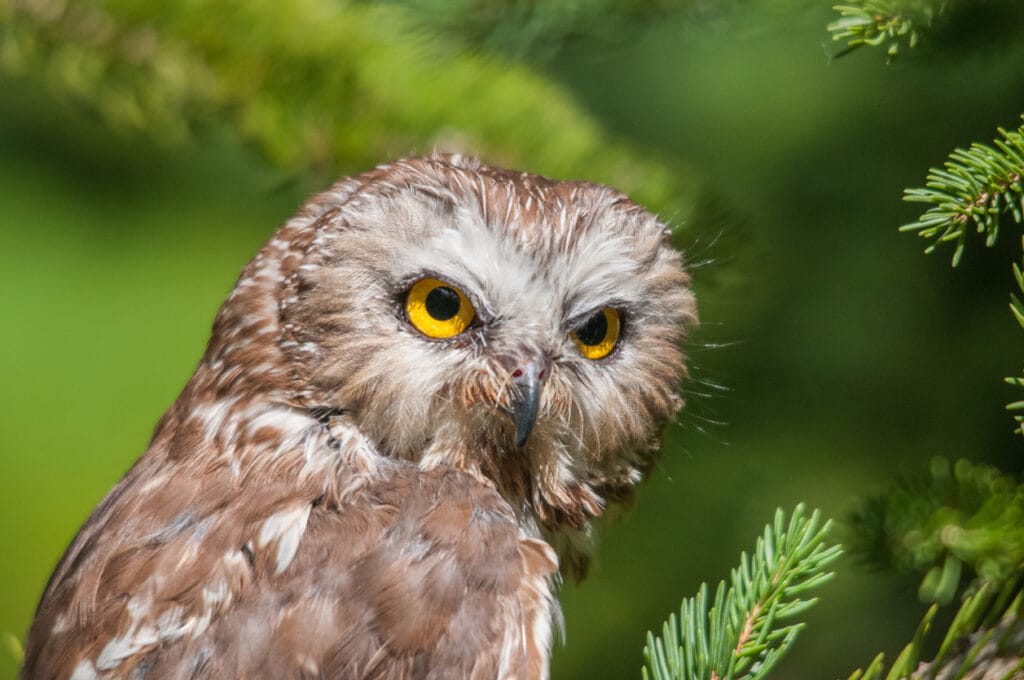
- Scientific Name: Aegolius acadicus
- Length: 7.1 to 8.3 in
- Weight: 2.3 to 5.3 oz
- Wingspan: 16.5 to 18.9 in
The Northern Saw-whet Owl is a very small owl and is one of the smallest in North America and the Carolinas, as their adults can be the size of some other owl’s chicks!
This owl is native to the region, so it’s usually found in abundant numbers, especially towards the north. Unlike other owls, this one is pretty elusive, which makes it pretty hard to spot, especially when you keep their size in mind.
Author Note: Despite their size, they have a distinctively loud tooting sound, which is the best way to track them.
In addition to their small body, they’re characterized by the white “V” above their eyebrows along with their brownish coloration across the body. Northern saw-whet owls usually feed on mice and other small rodents.
8. Eastern Screech-Owl
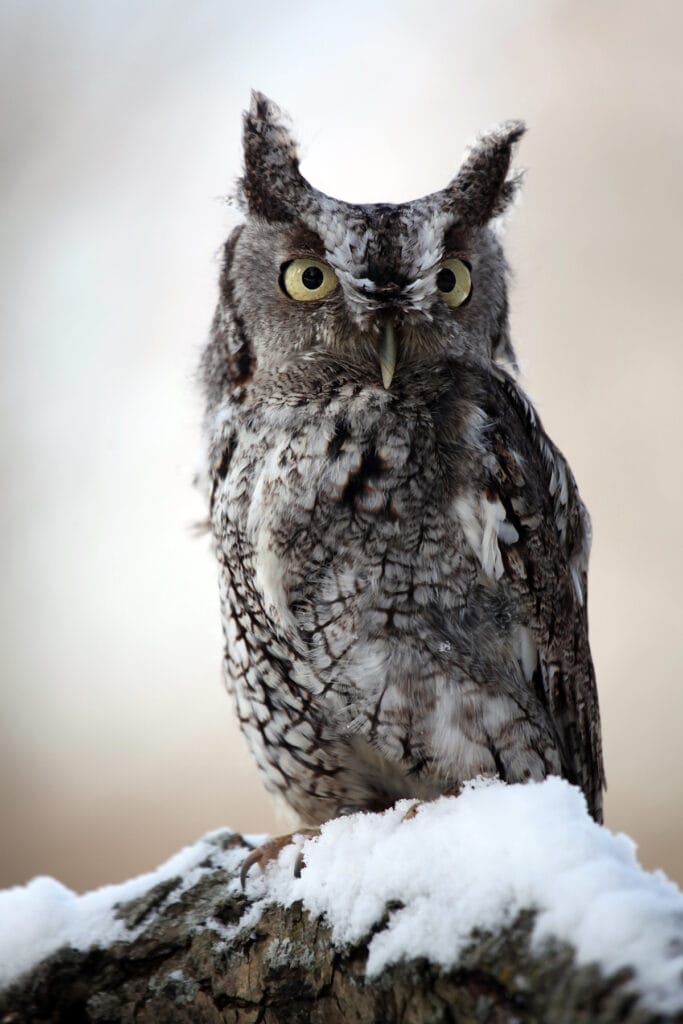
- Scientific Name: Megascops asio
- Length: 6.3 to 9.8 in
- Weight: 4.3 to 8.6 oz
- Wingspan: 18.9 to 24.0 in
The Eastern Screech-Owl is one of the iconic owls in terms of looks, as they’re used to depict the standard look of owls in arts and culture.
The owl is known for existing in two distinct varieties, which are the rufous and the gray, both of them are usually found in the state.
The bird’s heavily mottling is an excellent camouflage to hide them from their prey and predators.
They’re strictly nocturnal raptors, although they don’t mind living around residential areas if they’re quiet during the day.
The small owls have relatively large ear tufts for their size. Yet, you should know that these are false tufts, as their ears are located beneath them. Instead, they spread these tufts when they’re intimate to threaten competitors.
8. Long-eared Owl
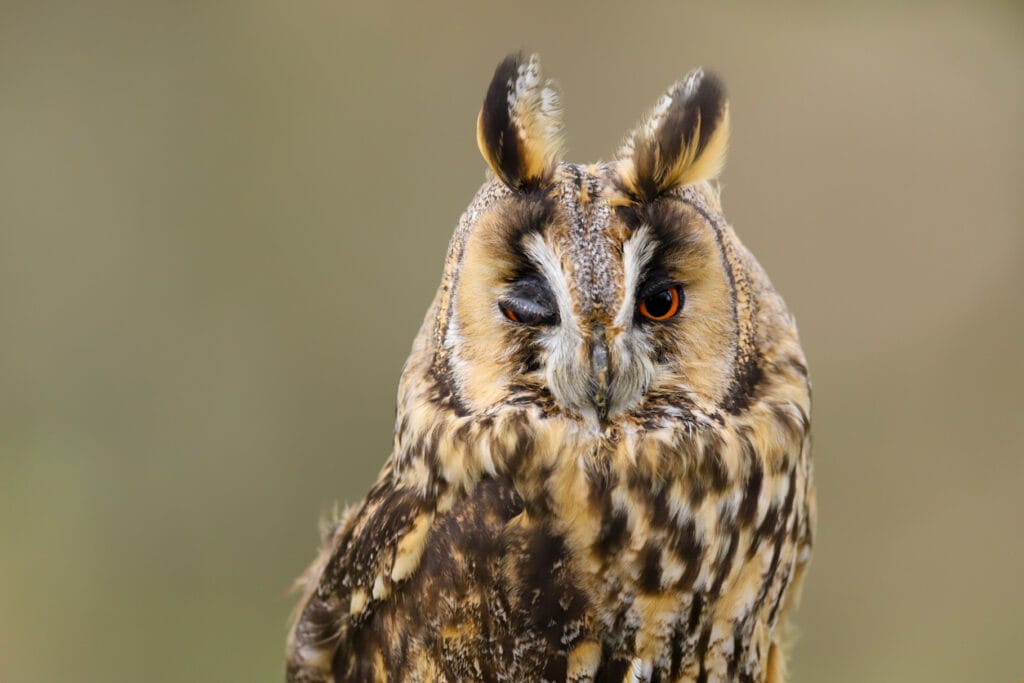
- Scientific Name: Asio otus
- Length: 13.8 to 15.8 in
- Weight: 7.8 to 15.3 oz
- Wingspan: 35.4 to 39.4 in
Long-eared Owls are considered medium-sized when compared to other owls on the list. The American variety is identified by their very distinctive yellow facial disks and the white marking between their eyes that looks like an “X”.
Author Note: They’re also more slender than other long-eared owls around the world and have a unique orange facial disk that makes them very easy to identify.
These birds have large yellow eyes that are usually closed during the day, as these owls are usually nocturnal. At night, these owls make a variety of calls and hunt small animals in open fields, such as squirrels, mice, voles, bats, lizards, etc.
9. Short-eared Owl

- Scientific Name: Asio flammeus
- Length: 13.4 to 16.9 in
- Weight: 7.3 to 16.8 oz
- Wingspan: 33.5 to 40.5 in
The Short-eared Owl is extremely similar in looks to the long-eared owl, as they both have the same pattern of mottling across their body, which allows them to hide in plain sight white perching on tree limbs and branches.
The only major difference between the two owls is the structure of the head, as the small-eared ones have very small ear tufts that may or may not show.
Another feature that can help you identify this owl is the dark accents that surround the facial disk of the owl.
These birds are usually more active from late afternoon towards dusk and typically hang around lands with sparse vegetation, which allows them to hunt small mammals and birds, as they like to fly low to pounce on their prey from above.
10. Boreal Owl

- Scientific Name: Aegolius funereus
- Length: 8.3 to 11.0 in
- Weight: 3.3 to 7.6 oz
- Wingspan: 21.6 to 24.4 in
Although the Boreal Owl isn’t officially listed as a common species of owls in the report of
North Carolina Bird Records Committee, there are multiple reports about sightings of the bird in the state, which means that it’ll be added to the list in the near future.
Author Note: The irregular resident of the state is known for having a small stocky body and a relatively large head. The owl is typically gray in color with white dots spreading across their facial disk.
Boreal Owls have large yellow eyes and usually prefer living in heavily forested areas. They usually feed on small mammals, especially rodents, as well as insects and smaller birds.
Final Thoughts
With that said, our guide about the amazing variety of owls in North Carolina comes to an end. As you can see, there’s a huge range of owl species in the Tar Heel State, which makes it an excellent spot for bird watchers with a special spot for owls!
We hope you enjoyed our guide on the most common owls in North Carolina.
FAQ
The Great Horned and Barn Owls are the most common in North Carolina.
To find out where recent sightings of owls have been, try eBird. You can search for the latest sightings or particular species or what has been seen in a certain area.
Check out these locations for owl sightings: Croatan National Forest, Blue Ridge Parkway/Mount Mitchell.




